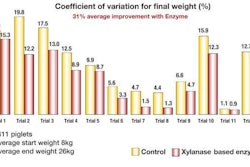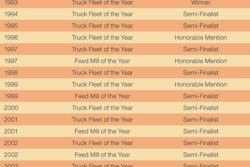The feed industry has been focusing on a number of trends impacting the animal feed business, from disease outbreak to competition for feed ingredients. But one issue that has perhaps not gotten its share of the spotlight may have some of the farthest-reaching implications for feed and livestock production: the growing world problem of water availability.
Earlier this year, FAO Director-General Dr Jacques Diouf addressed the issue of a growing global water scarcity. What he had to say was sobering: Global water use has been growing at more than twice the rate of population growth in the last century. "Water scarcity already affects every continent and more than 40 percent of the people on our planet," he noted. "By 2025, 1.8 billion people will be living in countries or regions with absolute water scarcity and two-thirds of the world's population could be living under water-stressed conditions."
Obviously, the worry over water scarcity is not limited to those of us in the feed and animal industries, but has far-reaching complications. As Dr Diouf stated, lack of access to adequate, safe water limits our ability to produce enough food and the capability for people to earn enough income. It cuts off our business and industrial potential and shrinks our ability to provide energy. It yields unhealthy hygiene and unsafe drinking water, leading to increased spread of life-threatening diseases like HIV/AIDS.
Global warming effects
And while that poster child of all world ills, global warming, may not be the only trigger behind the escalating water scarcity, experts say it is having a magnifying effect. "The water scarcity situation is being exacerbated by climate change, especially in the driest areas of the world," Dr Diouf says. "The human impact on the earth's environment and climate must be addressed in order to protect the world's water resources."
But a warming world is not the only factor adding to the water crisis. He admits there are other triggers involved, including increases in the amount of water needed for food production. While water scarcity may be of universal concern across industries, it is agriculture that is the greatest user of freshwater worldwide, despite trends toward urbanization and increases in domestic and industrial water use by people who live in more developed areas.
The International Water Management Institute (IWMI) has gone on record stating that biofuels will add to the strain on already stressed water resources. While environmental groups have turned up the volume on their concerns that booming biofuel production is increasing demand for land at the expense of nature, there is broader acknowledgement that biofuel production will require additional large quantities of water, already a major constraint to agriculture in many parts of the world, according to the IWMI.
An estimated 40 percent of the world's population lives in areas where water scarcity is a burdensome reality. IWMI's research under the Comprehensive Assessment of Water Management in Agriculture shows that at a global average, the biomass needed to produce one liter of biofuel evaporates between 1000 and 3500 liters of water, under prevailing conversion techniques.
Table 1: Water use, share of total withdrawals, percent
Solution through agriculture
But while agriculture may be the global giant of water usage, taming the thirsty beast of food production is not an easy solution to water woes. "First of all, there is no magic wand, no flip of the switch that is going to suddenly eliminate water scarcity. But there are concrete ways to turn the tide against water shortages," says Dr Diouf. "We at FAO recognize that the agriculture sector must take the lead in coping with water scarcity by finding more effective ways to conserve rain-fed moisture and irrigate farmlands." If growing food is still to be the fundamental stepping stone to fighting hunger and improving lives in all corners of the world, then stifling agriculture production in order to unburden water supplies is not the answer. Agriculture is estimated to be taking up to 70 percent of all freshwater withdrawn and up to 95 percent in several developing countries. "To tackle water scarcity even as the demand for food increases, we must support initiatives to produce more food with proportionally less water," points out Dr Diouf. "Again, this means protecting our waterways, keeping our forests healthy and improving the way in which we irrigate crops and manage livestock."
Table 2: Agriculture water withdrawal, select global regions
More efficient production
FAO advocates short-term, small-scale irrigation projects, including the development of low-cost and relatively simple, cost-effective methods that can be used by small farmers to irrigate crops. In a quest to break the water emergency cycle and put into place long-term, sustainable programs, FAO has organized and supported pilot programs in places like South Africa, Turkey and Mexico that center on small-scale irrigation or community-based systems for harvesting rainfall.
Not an easy task, Dr Diouf admits, and one that means working across national borders to develop and protect water basins.
Coping with water scarcity requires addressing a range of issues, not all of them directly linked to agriculture. They range from the environment and global warming to fair pricing of water services and equitable distribution of water for irrigation, industry and household use, according to the FAO. This is why not only the feed and agriculture sectors, but everyone international organizations, governments, local communities must share the responsibility.
"As a global community, we have the capacity to greatly improve the management of our water resources and provide access to water for more people," says Dr Diouf. "But again, we cannot do it without placing greater political priority on ensuring that everyone has access to water and without investing in programs which improve water conservation and delivery systems, protect the earth's ecosystems, conserve rain-fed moisture and use water for food production more efficiently."
.jpg?auto=format%2Ccompress&crop=faces&fit=crop&h=48&q=70&w=48)



.jpg?auto=format%2Ccompress&fit=crop&h=167&q=70&w=250)













